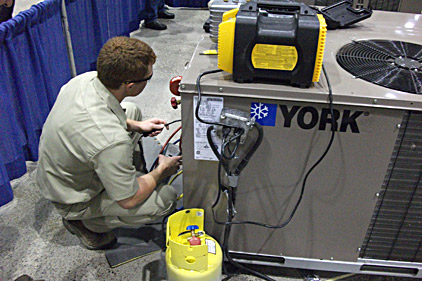
|
| After a system has been opened, or if gas has been introduced during service, the best way to remove noncondensable gas is to pull a good vacuum, as shown in this photo taken at a previous SkillsUSA competition. |
Noncondensable gases (NCGs), as the name implies, are not able to condense inside a condenser, unlike refrigerant gases. This can have a serious impact on system operating conditions, energy efficiency, and the lifetime of a system.
What Is an NCG?
The most common NCGs you will find in our trade are air, nitrogen, argon, and maybe carbon dioxide. These gases have boiling points so low that, for any practical condition you can experience in a system, they will remain in the gas phase.
Air enters a system from the surrounding atmosphere when a system is open. Air may also be drawn into a system through a low-side leak if the suction pressure drops below 0 psig. (Air should never be pressurized into a system on purpose since the oxygen in air might create a combustible mixture at higher pressures with refrigerants that contain hydrogen such as HCFCs and HFCs.)
When a system needs to be pressurized — for example, to perform leak checking — nitrogen or argon is commonly used. These inert gases are also purged through lines when brazing in order to reduce oxidation buildup inside tubing.
What Are the Effects of NCGs?
Refrigerant vapor is supposed to condense in the condenser. The process of condensation requires the refrigerant to get close to the walls of the tubing, transfer its heat to the copper, which then flows out to the fins and gets lost in the airstream outside.
Considering the basic heat transfer equation Q = U x A x Delta T, the condenser area (A) has been selected to reject the proper amount of heat (Q) based on the heat transfer coefficient of the refrigerant (U) and the difference in temperature between the air and the refrigerant (Delta T).
A noncondensable gas will remain as vapor in the condenser. It will not flow to the outlet like liquid refrigerant does, but instead it will remain trapped inside the condenser tubing. This will do two things:
1. The surface area taken up by the NCG will not be available for the refrigerant to use for heat transfer (A goes down), and
2. The air will reduce the overall heat transfer coefficient of the vapor inside the tube (U goes down).
In order to get the same total heat rejected, the heat transfer equation shows that if A and U go down, then Delta T has to go up. In other words, the refrigerant temperature has to go higher compared to the air temperature, which means higher discharge pressures.
With the system operating at a higher pressure, the extra work done by the compressor will decrease overall energy efficiency for the system. Discharge temperatures will also go up accordingly, which can lead to increased lubricant breakdown and shorter compressor lifetime. In addition, air contains oxygen, which promotes bad chemistry in the system.
How Do You Know You Have NCGs?
You should not automatically assume that high head pressure means NCGs. Other potential causes for high head pressure should be checked first. They include:
• Reduced airflow over the condenser coil;
• Dirty or blocked condenser coil;
• Hot air from the discharge side of the coil recirculated back into the inlet; and
• Too much refrigerant charge (verify by checking the subcool temperature).
If these have been ruled out, it is possible to check for the presence of NCGs in the condenser. So isolate the refrigerant in the condenser, take the compressor offline, and run the condenser fan. When the refrigerant in the coil has come to air temperature, measure the air temperature and the pressure of the refrigerant inside the condenser. If the measured pressure matches up with the pressure indicated on a pressure-temperature chart, then there are no NCGs in the coil. If the pressure is more than a few psi higher than the chart, then NCGs are probably to blame.
How to Avoid NCGs
After a system has been opened, or if gas has been introduced during service, the best way to remove NCGs is to pull a good vacuum. Evacuation is also needed to remove any moisture that may have entered the system while it was open. Be sure to purge air from charging hoses before opening system valves.
Removing NCGs
To remove NCGs from refrigerant in smaller systems, recover the entire charge and recharge with fresh refrigerant. It is hard to get to the vapor space in the condenser without tapping a line.
To remove NCGs from refrigerant in larger systems, use the nearest access valve to the vapor inlet to the condenser. Recover the vapor from the system for a long enough period to make sure that most of the vapor has been removed from the condenser. This will be a judgment call based on the size of the condenser, the amount of tubing between the condenser and the access point, and the vapor recovery rate of the recovery machine.
To remove NCGs from refrigerant in a recovery cylinder, given the density of refrigerant vapor and typical recovery rates of small recovery machines, it should take about two minutes to pull the air-filled vapor from a half-full 50-pound recovery cylinder. Adjust the time for cylinder size and fill level. The process should be repeated three or four times, shaking the cylinder around after each withdrawal. This will reduce the air by at least one order of magnitude (10 percent down to 1 percent). NOTE: Along with the removed air, there may be three or four pounds of vapor refrigerant also transferred to the new cylinder.
This material was prepared by National Refrigerants Inc. and based on material published in its newsletter, National News. For more information on the company, go to www.refrigerants.com.
Publication date: 05/28/2012







